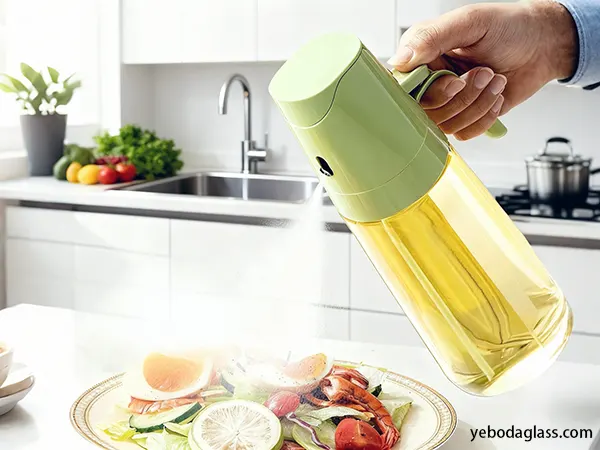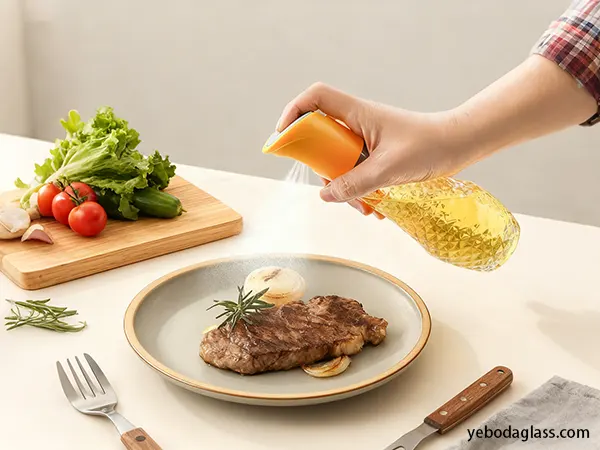Einführung
This report underlines a strategic approach to sorceing custom-branded kitchen oil spray bottles, which integrates detailed research on materials, adaptation, supplier landscapes, quality control and logical ideas. Its purpose is to identify and secure high quality, brand-grasped glass kitchen oil spray bottles that meet specific aesthetic, functional and budgetary needs. The major findings highlight a diverse supplier market, especially in Asia, offer various materials (glass, BPA-free plastic, stainless steel) and adaptation techniques. For example, the Ja, ja. kitchen oil spray bottle, combines premium glass bottle with advanced spray functionality, provides accurate oil distribution while maintaining a smooth beauty. Its durability, UV protection, and ergonomic nozzle design simulates the advantages of choosing a high quality Küchenöl-Sprühflasche for both home and professional culinary environment. The emphasis is placed on understanding international trade complications to reduce the strong supplier vet, stringent quality assurance protocols, and risks and ensure a successful sourcing results.

Demand Forecasting and Unit Economics
Order Volume and Economies of Scale
Estimated order volumes and target unit price custom are the major drivers in developing sourcing strategies for kitchen oil spray bottles. High orders unlock the economies of the volume scale and reduce the unit cost. When the order volume is sufficient, manufacturers are more likely to invest in custom tooling and offer competitive pricing. In contrast, lower-ended versions may require cost obstacles or adjustments for per-to-domestic options. These minimum order quantity is important to align source strategies with an estimated demand.
Target Price and Adaptation Remaining
The target price determines the viability of material and optimization. Advanced mold design or printing technique increases per-unit cost. Strategies to customize unit economics include:
- To interact on volume discounts to avail bulk order.
- Searching for off-the-shelf design with branding adaptation, focusing on logo, color, or label, which is more cost effective than complete mold growth.
- Integrated orders in many product lines to obtain high volume.
- To understand the landed cost to evaluate supplier pricing models (FOB, CIF, DDP).
Material Science and Product Integrity
The choice of material for oil spray bottles directly affects durability, safety, aesthetics and brand positioning. The primary options are glass, stainless steel and BPA-free plastic.
Glass kitchen oil spray bottles are preferred for their accelerated, non-thread nature and premium appearance. They preserve the taste of oil, do not maintain smell, and fully recycled.
Benefit:
- Chemical inertia, non-reactive, protects the quality of oil.
- Premium touch and visual clarity.
- UV security options to expand shelf life (green or amber glass).
- Relative and durable.
Verlust:
- Defeat, heavier than plastic, high cost.
Yeboda glass kitchen oil spray bottle bottle bottle bottle, UV security, ergonomic design and the optimal combination of advanced continuous-motist nozzle technology, ensure accurate application and a better culinary experience.
BPA-Free Plastics
BPA-free plastics provide a mild, shatterproof option. Food-grade certification is important to prevent chemical leaching.
Nutzen:
- Lightweight, shatterproof, moldable in diverse shapes.
- Effective cost.
Verlust:
- Possible odor absorption, environmental concerns.
Edelstahl
Stainless steel provides durability, corrosion resistance and a modern beauty. Custom increases engraving or laser capture branding.
Nutzen:
- High durability, corrosion-resistant, dishwasher safe.
Verlust:
- High cost, limited transparency, potential metal flavor.
Customization Modalities and Branding Integration
Logo Printing and Surface Treatments
Customization ranges from basic logo application to intricate designs.
Techniques:
Silk Screen Printing, UV Printing, Hot Stamping, Decals, Labeling, Engraving/Etching.
Überlegungen:
Durability (oil/water resistance), artwork format, color count, MOQ.

Custom Mold Design and Unique Features
Custom molds allow unique bottle shapes, sizes, and functional elements.
Capabilities:
Providers like Seme Packaging, Sanle Plastic, Xuzhou Minghang Packaging, PAGpackaging, and Unique Blowmoulding Inc. support custom mold creation with prototyping and industrial design expertise.
Cost & Lead Time:
Mold development ranges from $10,000 to $50,000. Lead time may extend several months.
IP Protection:
Trademarks, design patents, and copyright protect bespoke elements.
Düsenmechanismen und Funktionalität
Innovative nozzles improve usability:
- Continuous Mist Sprayers: Even oil distribution.
- Adjustable Nozzles: Switch between fine mist and controlled pour.
- Metering Sprayers: Precise dosage per spray.
- Self-Cleaning & Anti-Clogging: Maintains consistent performance.
Materials are typically high-grade glass or stainless steel to ensure longevity. The Yeboda kitchen oil spray bottle integrates these nozzle innovations for enhanced user experience and healthy cooking.
Supplier Landscape and Geographical Sourcing Strategies
Supplier Categories
The global supplier landscape for bottles of kitchen oil spray is diverse, with a significant concentration of manufacturers especially in Asia, China.
- Direct manufacturers: Produces bottles themselves, provide direct control over production and competitive pricing for larger versions.
- Trading companies: Source from many manufacturers should act as middlemen. Provide broad product range and logistics assistance but can take a little higher cost.
Geographical Sourcing Preferences
Domestic Sourcing (US/Europe):
- Vorteile: Small lead time, easy communication and strict quality control standards.
- Nachteile: High MOQs can cause high unit costs and custom tooling may be required.
International Sourcing (China):
- Vorteile: Low unit cost, adaptability and mass production capabilities.
- Nachteile: Long Lead Times, Communication Barrier, Complex Logistics and Strict quality control.
Note: For custom glass kitchen oil spray bottles, Chinese manufacturers in Guangdong and Zhejiang have a comprehensive experience with export processes and complex modifications.
Prototyping, Sampling, and Quality Assurance Protocols
Prototyping
Customizing the glass kitchen oil spray bottle mold is crucial and requires verification of form, fit, and function.
Sampling
- Obtain physical samples to evaluate materials, nozzle function, aesthetics, and print quality.
- Some suppliers offer free samples.
Quality Assurance Checkpoints
- Pre-Production Inspection (IPC): Verify raw materials.
- During Production Inspection (DUPRO): Identify issues mid-production.
- Pre-Shipment Inspection (PSI): Confirm final products meet specifications.
- Container Loading Check (CLC): Verify correct products loaded.
- Material Testing: Ensure food-grade compliance (FDA, EU 10/2011).
- Functional Testing: Confirm nozzle performance, durability, and spray consistency.
The Yeboda glass kitchen oil spray bottle undergoes rigorous QA to ensure consistent mist delivery, durability, and safety compliance, providing a superior experience for consumers.

Logistics, Import/Export Considerations, and Fulfillment
Shipping Methods
- Ocean goods: low cost for wholesale shipment; The longest transit time.
- Inventory Management Software (IMS): Fast, but high cost; Suitable for immediate or high-value shipment.
- Express delivery (DHL, Fedex): fastest for samples or small orders; Costaliers is the fastest for wholesale shipment.
Customs Duties and Tariffs
- Calculated duties based on CIF value.
- HS code classifies products and determine tariffs.
- U.S.: D Minimis Threshold was abolished; All shipments are subject to duty.
Import Regulations
Compliance with food safety standards and labeling requirements is mandatory.
Documentation
Commercial invoices, packing list, bill bill/air webl, and certificate of origin are included.
Freight Forwards and Supply
Frequent forwarders such as AFC Internationals manage shipping, customs withdrawal and warehousing. Consider post-recess storage and supply strategies to efficiently distribute oil spray bottles.
Risk Assessment and Mitigation Strategies
Sourcing kitchen oil spray bottles include possible risks:
Supply Chain Disruption
- Reason: Natural disasters, geo -political issues, crowds of port.
- Mitigation: Buffer lead time, diversity in suppliers, maintaining communication.
Quality Control Failure
Getting defective or non-non-transport products.
Mitigation: Multi-stage QC, third-party inspection, clear contract specification.
Intellectual Property Violation
Risk of copying design.
Mitigation: Design Patent, Trademark, NDA and iconic supplier.
Unexpected Cost Increases
Raw material prices ups and downs, shipping costs, currency changes.
Mitigation: Fixed pricing agreement, cost adjustment section, currency hedging.
Non-Compliance with Regulations
- Risiko: FDA, Non-originated with European Union standards or local import laws.
- Mitigation: Verify the certificate and compliance documentation.

Future-proofing and Scalability
Suppliers Flexibility
Select partners capable of increasing production for increasing demand.
Long-term partnership capacity
Strong relationships achieve better pricing, preference treatment and collaborative product development.
Neue Technologien
Monitor progress in manufacturing (molding, permanent material) and adaptation (UV/laser printing, smart coatings).
Beispiel: Smart coatings with microbial sensors or bio-sources epoxy resins indicate future trends.




